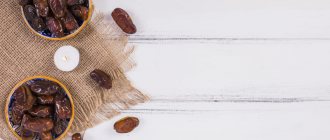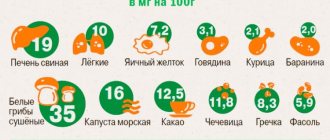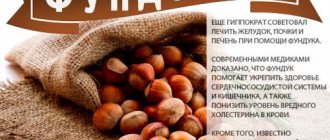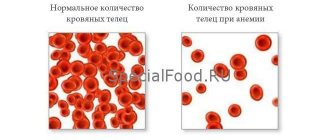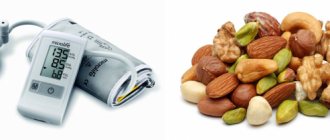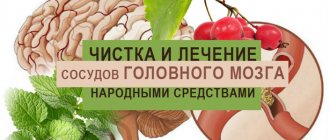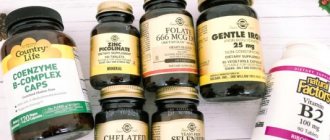Reduced hemoglobin comprehensively worsens the condition of the body, since in this case all organs and tissues experience oxygen starvation.
And this is complemented by an increased load on the cardiovascular system - the body simply accelerates blood flow to increase the flow of oxygen.
Hemoglobin deficiency and anemia are especially dangerous in preschool children - this often provokes the development of pathologies of the nervous system, which ultimately leads to mental retardation.
According to numerous studies , hemoglobin levels can be regulated by diet, including or excluding iron-containing foods from the diet.
We have compiled a rating of the 20 most effective foods that should be included in your diet to increase the concentration of hemoglobin in the blood. We will also describe general principles of nutrition and recommendations from doctors.
Let's remember that in the last article we looked at 7 products that reduce hemoglobin levels.
Top foods containing iron
Women should consume at least 18 mg of iron per day, men - 10 mg. The list of products that naturally increase the concentration of hemoglobin in the blood has long been compiled.
The leaders in iron content are the following products (per 100 g):
- Pork liver 20.2 mg;
- Chicken liver 17 mg;
- Dark chocolate 12 mg;
- Oysters 9.2 mg;
- Pumpkin seeds 9 mg;
- Beef liver 7 mg;
- Beef heart 4.8 mg;
- Pork heart 4.1 mg;
- Beef meat 3.6 mg;
- Lamb meat 3.1 mg;
- Pork meat 1.8 mg;
- Chicken meat 1.6 mg;
- Turkey meat 1.4 mg;
- Mussels 6.7 mg;
- Sardines 2.9 mg;
- Chicken yolk 6.7 mg;
- Quail yolk 3.2 mg;
- Beef tongue 4.1 mg;
- Pork tongue 3.2 mg;
You should also include in your diet:
- Pistachios 60 mg;
- Spinach 13.51 mg;
- Lentils 11.8 mg;
- Peas 6.8-9.4 mg;
- Buckwheat 8.3 mg;
- Barley 7.4 mg;
- Oatmeal 5.5 mg;
- Wheat 5.4 mg;
- Peanut 5 mg;
- Dogwood 4.1 mg;
- Cashew 3.8 mg;
- Corn 3.7 mg;
- Pine nuts 3 mg.
The list indicates the amount of iron that is present in 100 grams of the product.
Factors influencing hemoglobin
The main hemoglobin is iron. It is through the process of its oxidation and reduction that oxygen is transported and absorbed in the tissues of a living organism.
Iron deficiency is one of the most common causes of a sharp decrease in hemoglobin levels.
However, simply including iron-rich foods in your diet is not enough. This microelement cannot be fully absorbed without certain factors. For example, to break it down into derivative atoms (which then react with certain groups of proteins), vitamin C, B vitamins (especially folic acid), omega-3 and omega-6 unsaturated fatty acids are needed.
At the same time, there are a number of factors that reduce the bioavailability of iron. For example, a high level of calcium in the body inhibits the production of new hemoglobin molecules. If there is a deficiency of the above microelements, iron simply will not be absorbed.
It is also worth considering that a decrease in hemoglobin levels can be provoked by a whole range of diseases of the cardiovascular system and gastrointestinal tract. That is why you should not delay going to the doctor - it is better to immediately establish the cause of hemoglobin deficiency and eliminate this particular factor.
If a low hemoglobin level is caused by a deficiency of micronutrients, then it is recommended to include the following foods in the diet:
- rich in iron;
- rich in vitamins C, E, B-group;
- rich in amino acids (preferably of animal origin);
- exclude those foods that reduce the bioavailability of iron.
In most cases, the above list of recommendations will be enough to normalize the composition of formed elements in the blood.
Subtleties of increasing hemoglobin
Iron-rich foods are the best way to combat low hemoglobin.
Pomegranate fruits, which have “deposits” of iron, effectively help increase the level of this iron-containing complex protein. The juice made from them is also useful.
Red grape wine is an effective assistant in increasing hemoglobin. However, this drink is prohibited for expectant mothers.
Even a diet menu based on the use of iron-containing dishes does not guarantee success. The production of hemoglobin that occurs in the body depends not only on this substance. You also need to take care of your copper intake.
Pear is a fruit that speeds up the process of restoring healthy levels of iron-containing protein. It is often recommended by doctors for patients suffering from anemia, especially if iron supplements do not produce results.
Honey not only improves the situation with hemoglobin, but also has a restorative effect on the body. It is recommended to eat about 50-70 g of healthy sweets every day.
The absorption of iron will become better if you include foods rich in vitamin C. The best effect is provided by freshly squeezed fruit drinks and citrus fruits. Buckwheat contains folic acid, which activates the process of hematopoiesis. Bananas are recognized as a supplier of vitamin B6, without which hemoglobin cannot be normalized.
There are also a number of long-acting drugs:
- heferol;
- ferrogrademet;
- ferrograd;
- irovit;
- sorbifer durules;
- fefol;
- Tardiferon-retard.
Drugs that are effective for a short period of time are ferrous gluconate, ferrous fumarate, ferrous sulfate.
Traditional medicine offers its own methods of combating low hemoglobin.
The following recipes will be useful:
- Raisins, prunes, dried apricots and walnuts are taken in equal quantities and mixed thoroughly. The resulting mixture is processed using a meat grinder and supplemented with a small amount of honey. Every day you need to consume this sweet dish in the amount of 6 tablespoons.
- Freshly squeezed carrot juice is effective in increasing hemoglobin; 300-400 ml per day will benefit the body. Beetroot juice is mixed with honey in equal proportions, the mixture is consumed in the amount of 2 tablespoons three times a day.
- Red clover helps normalize the substance. 4 heads of the plant are dissolved in boiling water and infused for half an hour. Treatment lasts for a month, the mixture is consumed half a glass three times a day, preferably taken before meals.
- “Compote” made from fresh juices mixed in equal (100 g) parts effectively helps increase hemoglobin. Necessary juices: apple, carrot, beetroot, pomegranate. You should add 50 g of honey, consume 2 spoons three times a day.
- Blue blackberry (2 parts leaves), mixed with white clasp grass (2 parts), St. John's wort grass (3 parts). Take a tablespoon of the resulting composition and pour it with a glass of boiled water. Infuse the mixture for three hours, take a spoon three times a day for 30 days.
Recipes for dishes that increase hemoglobin
Let's consider what can be prepared to bring hemoglobin back to normal.
Recipe 1. Beef liver shish kebab with apples
Cut 1 kg of beef liver, cleared of ducts and films, into medium-sized pieces.
Chop 2 onions into rings.
Cut one large green apple into large pieces, and grate the second (of the same size).
The next step is to prepare the marinade. Mix the resulting applesauce with 3-4 tablespoons of soy sauce, 1 tablespoon of apple cider vinegar, half a glass of water, 1 tablespoon of chopped parsley.
Pour the marinade over the prepared onion rings, pieces of beef liver and apple, stir, then let sit for 1 hour.
String all the ingredients in this order: liver, apple, onion.
Cook the shish kebab on the fire for no more than 15 minutes. Otherwise, the liver will become dry.
Serve the dish piping hot.
Recipe 2. Beef meatballs with eggs and olives
Place 500g minced beef in a bowl.
Cut 3 ripe tomatoes into cubes.
Grind cilantro, parsley, fresh mint - 1 tablespoon each.
Finely chop 1 large onion, 2 cloves of garlic.
Add 1 teaspoon of onion and half of chopped garlic to the minced meat. Mix.
Sprinkle the minced meat with chopped herbs - take half. Mix.
Drizzle the mixture with 2-3 teaspoons of olive oil.
Add salt and pepper to taste. Mix the contents of the bowl.
Season the minced meat with spices: ginger, ground cumin, sweet pepper (paprika) powder, turmeric - 1 teaspoon each.
Mix the mass well.
After half an hour or an hour, make meatballs from the minced meat with herbs and spices - balls the size of a walnut. Set aside.
Pour 4-6 tablespoons of olive oil into the pan. Sauté the remaining onion and garlic in oil. Stirring, add greens (leave half the cilantro) and tomatoes.
Salt and pepper. Sprinkle with seasonings - 1 teaspoon each. Mix.
Place meatballs in pan. Cover and cook over very low heat for about 35 minutes.
Then add 4 eggs to the meatballs one at a time. To cover with a lid.
When the whites are cooked, evenly place 1 cup pitted green olives on the meatballs. To cover with a lid. Boil a little more until the eggs are ready.
Sprinkle with chopped cilantro and serve immediately.
Recipe 3. Fried lamb liver
In order for the dish to be beneficial, you should use fresh, unfrozen lamb liver.
It is necessary to cut off the film, clean 150-200 g of the liver from the bile ducts. After washing, chop the product quite finely.
Pour a little vegetable oil into the frying pan and heat it well. Then lay out the liver, reduce the heat to medium. Fry for a minute and a half.
Turn the liver over to the other side. After a minute or a minute and a half, the product will stop bleeding.
Salt the liver to taste. You can add a little crushed garlic and stir.
Close the lid and turn off.
It is useful to eat fried liver with the addition of greens.
This dish must be prepared once a week for a month.
Recipe 4. Buckwheat with beef on a vegetable “pillow”
Cook buckwheat porridge. You will need 3 tablespoons of cereal.
Mix 300 g of ground beef with chilled buckwheat porridge.
Add 1 egg, salt, pepper (to taste).
Stir in the minced meat.
Make meatballs from the prepared mixture.
Grease a baking dish with vegetable oil.
In order for the balls to set, keep them in the oven for 20 minutes at 200 degrees.
At this time, coarsely chop 1 onion, 200 g pumpkin and 1 sweet pepper.
Pour some oil into the pan and add the vegetables. You can add nutmeg.
Place the buns on a vegetable bed.
Add 300-400 ml of water to the pan.
Simmer the dish for 30-40 minutes.
Buckwheat with beef is good for both adults and children. You can give them to children from one and a half years old.
Recipe 5. Pork with sauce
Cut 1.2 kg of pork pulp crosswise into 6 escalopes (portioned pieces), lightly beat and rub with salt.
Mix 250 g of dry white wine in a small bowl with 180 g of orange jam or marmalade. Pour in 2 tablespoons of vegetable oil and mix thoroughly.
Add 1 cm of ginger root, finely chopped.
Pour the prepared marinade over the pork pieces.
Cover the dish with a lid and place in the refrigerator for 3 hours. After a while, shake the pan and turn the escalopes over.
Remove the loin pieces from the marinade, dry them, and bake on the grill. If it is not available, you can fry the escalopes on both sides until cooked.
Place on serving plates.
Pour the remaining marinade into the saucepan, bring to a boil and cook until thickened for 3-5 minutes. Pour the sauce over the pieces of meat.
When serving, garnish the pork with baked vegetables, zest and orange slices.
Recipe 6. Superman salad
Take 200 g of boiled (or canned) shrimp. If there are large ones, cut them.
Chop 100 g of cucumbers and 35 g of lettuce into strips.
Cut 140 g of sweet onions into half rings.
Boil the marinade of water (0.5 l), salt (0.7 tablespoon), granulated sugar (2 tablespoons) and spices for 5 minutes. Hot, adding vinegar (0.5 teaspoon), pour onion onion for 4-6 hours.
Drain the water.
Mix all ingredients with 100 g of mayonnaise.
Place in a salad bowl, garnish with pitted olives (20 g), lettuce, and herbs.
Recipe 7. Salad with chicken liver and poached egg
First, coarsely chop 2 tomatoes and 1 bell pepper and place on a plate along with 50 g of lettuce.
Chop 400 g of liver and half an onion, fry them in 20 ml of vegetable oil. Lightly pepper and add salt to the vegetables.
Place a poached egg on top.
How to cook it? Break a fresh egg into a bowl and carefully pour into hot water. Wait until the yolk is wrapped in white. The egg should be in hot - not boiling - water for 5-10 minutes.
Cut the poached egg a little - the yolk will soak the lettuce leaves.
Pour the dressing over everything by mixing honey, hot mustard (1 teaspoon each) with balsamic vinegar and olive oil (20 ml each), salt and pepper (to taste).
Recipe 8. Salad with chicken and apples
Take 40 g of green salad leaves and chop some of them.
Cut 4 tomatoes into slices.
After coreing 4 apples, cut into slices, lightly frying in some vegetable oil (4 tablespoons in total).
Cut 250 g of smoked chicken fillet into slices, add salt and pepper (to taste), and fry until golden brown in the remaining oil.
After combining the prepared ingredients, pour over the dressing. Prepare it by mixing 3 tablespoons of balsamic vinegar, 1 teaspoon of sugar, salt and ground black pepper to taste, gradually pouring in the oil, whisking.
After mixing everything, place the salad with chicken and apples on green lettuce leaves and sprinkle with 2 tablespoons of walnuts.
Recipe 9. Chicken pate with nuts
500 g chicken liver, washed, peeled and cut into small pieces.
Add pre-cut finely chopped carrots, fried onions (take 1-2 vegetables at a time), and simmer everything.
10 minutes before readiness, add salt, pepper (to taste), 1-2 cloves of garlic (optional).
Cool. After adding herbs and walnuts (100 g), grind the resulting mass using a meat grinder or blender.
Do not include butter. The question "why?" will not arise for those who carefully read the entire article.
To avoid blackening, grease the top part of the pate with any vegetable oil. Decorate with greens.
Recipe 10. Buckwheat cutlets in the oven
1 cup of buckwheat, rinsed, boiled in salted water in a ratio of 1:2.5.
Beat 2 eggs into finely chopped carrots and onions (1 each).
Add 1 coffee spoon of spices - red pepper, black pepper, thyme.
Add 2 tablespoons of flour to thicken the mixture.
Mix everything.
Form buckwheat cutlets using a spoon. One tablespoon is enough for one cutlet.
Place on a baking sheet and bake in an oven preheated to 200 degrees.
Buckwheat cutlets in the oven are ready when they acquire a golden crust.
Recipe 11. Sandwiches with red caviar, lemon, parsley and dill
For sandwiches, it is better to take slightly stale bread: it will not crumble when cut.
Cut the bread into thin slices (thickness no more than 1 cm).
Taking the butter from the refrigerator, wait 15-20 minutes until it melts a little - it will be easy to spread on bread.
Cover each slice of bread evenly with a thin layer of butter (about 2 mm).
Finely chop the dill and sprinkle it on top of the butter.
Use a teaspoon to evenly distribute red caviar on the sandwiches.
Cut the lemon into small pieces.
Garnish the sandwiches with citrus and a sprig of parsley.
For better absorption of nutrients from red caviar, you can exclude butter from the recipe.
Adults should use no more than 4 teaspoons of caviar per day. For a week - 150 g.
Children should be given red caviar from the age of three, literally “bit by bit.” Gradually increasing the portion, bring it to 2-3 teaspoons per day. Use caviar in childhood 2 times a week.
Recipe 12. Salad “An Athlete’s Dream”
After boiling the beets (you will need 2 pieces in total), grate them. Place part of it in a layer on the bottom of a deep plate, lightly grease with mayonnaise.
Place 250 g of chopped prunes on top, 250 g of finely chopped fish on top (lightly salted chum salmon or mullet are suitable), grease with mayonnaise.
Then lay out the grated sweet and sour apple, having previously peeled it, on top - a layer of 250 g of chopped dried apricots, coat with mayonnaise.
Next is another layer of grated apple.
Cover the top with grated beets, grease with mayonnaise, garnish with dried apricots and prunes.
Let the salad sit for 30 minutes.
Video recipe. Orange salad and bean toast
What vegetables increase hemoglobin?
Beetroot helps to cope most effectively with iron deficiency; it is useful in raw or boiled form. This product ensures the regeneration of iron content, “starts up” red blood cells, and enriches the blood with oxygen. Other vegetables will help increase hemoglobin.
- Carrot. The product is consumed fresh, can be added to salads, and can be boiled.
- Tomato. The vegetable improves blood composition, saturates it with essential elements, and prevents the formation of blood clots. Tomatoes do not lose valuable qualities after heat treatment.
- Potato. The vegetable is saturated not only with iron, but also with other useful elements - calcium, phosphorus, potassium, magnesium, vitamins and organic acids. It is included in the menu boiled.
- Zucchini. The product is rich in iron, potassium and magnesium. The vitamin C content helps in the absorption of iron.
All of these vegetables strengthen the body, restore the functioning of the intestines, which makes the fight against low hemoglobin more effective.
What fruits increase hemoglobin?
Modern research has found that the first fruit in the fight against iron deficiency is the fresh peach. 4 mg are present in 100 g of fresh product, in dried - about 3 mg. The following fruits are also relevant.
- Quince. Adding 100 g to the menu provides 3 mg of iron.
- Persimmon. Eating 100 g of fruit “gives” the body 2.5 mg of iron.
- Pear. In addition to iron (2.3 mg), the fruit is rich in zinc, manganese, cobalt, copper, and is effective in treating anemia.
- Apple. For a long time it was considered the number one fruit in the list of fruits that increase the concentration of hemoglobin in the body. When fresh, 100 g of apples contain 2.2 mg. The indicators of dried fruits look better - approximately 2.7 times more.
- Pomegranate. By eating 100 g of the product, you can replenish iron reserves by 1 mg. It is also good for its abundance of valuable vitamins.
- Apricot. It is best consumed in dried form, the concentration of essential elements increases. The fresh product is also useful - 0.7 mg. In addition to iron, apricots contain cobalt, manganese, and copper. All these elements together are useful for anemia and activate hemoglobin biosynthesis.
- Kiwi (0.8 mg) and fresh plums (0.5 mg) will be beneficial for the body.
- Watermelon is famous for its high concentration of iron; its consumption can enrich the body with other valuable substances - potassium, vitamins. Not only is the hemoglobin level restored, but also energy increases, and the person gets rid of chronic weakness.
Iron absorption is a process that occurs in the proximal intestine. There are certain foods that contain phytates and phosphates that inhibit it. The solution to the problem will be to include in the menu fruits that activate the absorption of iron and are endowed with vitamin C. The most beneficial will be all citrus fruits, melon, pineapple, and sour apples.
Symptoms of low hemoglobin and consequences
For an adult, the normal hemoglobin level is as follows:
- for women – from 120 to 150 g/l;
- for men – from 130 to 160 g/l.
In old age, the hemoglobin level in most cases increases up to 180 g/l - this is not considered a dangerous deviation and, as a rule, is assessed as a “stable norm”. In pregnant women, the range of normal levels also expands slightly and can range from 110 to 155 g/l - this is due to temporary changes in blood flow.
Doctors identify the following symptoms of low hemoglobin:
- a feeling of constant fatigue (even if a person sleeps a fairly large amount of time and follows a day and night routine);
- regular headache without changes in blood pressure;
- manifestation of yellowness of the skin;
- deterioration of skin and nails;
- muscle weakness;
- dyspnea;
- slight decrease in blood pressure.
- In critical cases, a person may lose consciousness.
Why is low hemoglobin so dangerous? Oxygen starvation of all organs, the brain, which accelerates the process of deactivation of nerve cells. Along with this, muscle atrophy develops, the walls of blood vessels become thinner and less resistant to rupture (with low hemoglobin, subcutaneous bleeding in the form of capillary networks often occurs).
Also, low hemoglobin may be accompanied by persistent angina and the development of other chronic diseases of the cardiovascular system.
Low hemoglobin is especially dangerous for newborns. In the first few months, the norm for them is from 180 to 240 g/l. This is due to the fact that at this time their nervous system is still actively developing and this is what oxygen is used for. A drop in hemoglobin to 130 g/l can trigger the development of brain pathologies.
It is worth considering that an increased level of hemoglobin also harms the body. In this case, blood viscosity increases, increasing the risk of thrombosis. Also, increased hemoglobin is accompanied by nervousness and decreased resistance to stress.
Which berries increase hemoglobin?
Berries will also help improve hemoglobin levels when levels are low. You should definitely eat cranberries and black currants; the products are healthy not only fresh, but also frozen. Cranberries can be mixed with sugar. Strawberries, strawberries and blueberries are also recommended for iron deficiency.
A berry that is useful for anemia and anemia is rowan. To achieve the effect, you must eat at least a tablespoon daily.
What should be excluded from the diet?
A decrease in hemoglobin levels is facilitated by:
- Almost all dairy products. They contain protein and complex carbohydrates, which slow down the process of hemoglobin synthesis. Milk also thickens the blood.
- Pasta. This also includes all cereals. They interfere with the absorption of iron, oxidizing it while still in the gastrointestinal tract. Such a micronutrient is no longer suitable for the formation of hemoglobin cells.
- Chicken eggs. It is the protein they contain that lowers hemoglobin. In principle, any food based on protein slows down the absorption of iron.
- Wheat flour and all products derived from it. Regular consumption of wheat bread leads to a decrease in hemoglobin by an average of 15 g/l. Therefore, it is better to give preference to black or coarsely ground bread (bran).
Which nuts increase hemoglobin?
Of the nuts that are used in the fight against low hemoglobin, walnuts are the most useful. The product contains iron, potassium, magnesium, cobalt, and a large number of vitamins. This composition allows it to stimulate the process of synthesis of the necessary substance and have a strengthening effect on a weakened body.
Eating nuts in combination with raisins is beneficial for hemoglobin. Half a glass of raisins is soaked in water for 2 hours. Then the water is drained, the raisins are mixed with walnuts (20 g is enough). The dish is divided into three servings, the approximate volume of each serving is a couple of tablespoons.
You can also try a combination of nuts with cranberries and honey. All these elements are mixed using a blender.
Fresh juices
Store-bought juices will not be useful in the battle with low hemoglobin; only natural products will be useful. Freshly squeezed drinks are perfectly absorbed and are rich in a huge number of vitamins. During the treatment process, it is worth preparing them two to three times a day and using them immediately after preparation.
Champions for eliminating iron deficiency in the body: carrot, apple, beet juice. Other freshly squeezed foods will also benefit.
- Fresh zucchini juice mixed with carrot or potato juice is extremely beneficial. It activates intestinal peristalsis, has a calming effect, and promotes the absorption of iron thanks to potassium, magnesium and vitamin C.
- Potato (freshly squeezed) juice helps solve the problem of low hemoglobin. The drink is drunk 30 minutes before a meal; it is enough to take about half a glass 2-3 times a day. Red potatoes are optimal for making juice.
- The benefits of pomegranate juice, once popular as a drink that restores iron levels in the body, are disputed by modern medicine. It is believed to cause constipation and a number of other side effects.
Carrot
Carrot juice has long been used to improve hemoglobin synthesis in the body. To restore the process, you need to drink about 2-3 glasses a day, about half an hour before meals (or an hour after meals).
Excellent results will be provided by a drink prepared from freshly squeezed juices of beets, carrots and radishes. To improve the situation with hemoglobin and increase the concentration of iron in the blood, the composition is taken in the amount of 2 tablespoons per day, treatment lasts a month.
In order for carrot juice to be better “perceived” by the body, you should eat sour cream (in a small amount) before drinking it, so the valuable components will be better absorbed.
Beetroot
Beets are a useful product for low hemoglobin, especially effective in the form of freshly squeezed juice. Good results are ensured by consuming a mixture of carrot and beetroot drinks, the recommended proportion is 2:1.
Beetroot juice should not be taken in large quantities due to its increased biological activity. The drink may have an irritating effect on the mucous membranes. Therefore, you should drink it exclusively in combination with soft formulations, not exceeding a dose of half a glass per day (divided into several doses). You should definitely keep the freshly prepared mixture in the refrigerator for 3 hours in an open container.
Apple
Unlike beet and carrot juice, which do not have an attractive taste in their pure form, apple juice is a tasty medicine. To enrich the body with iron, you can use it either alone or in combination with the juice of other vegetables (carrots, beets).
For example, you can prepare a drink by taking a quarter glass of carrot juice, a quarter of beet juice, and half of apple juice. The thoroughly mixed mixture is consumed twice a day.
All of the above products are not only effective tools for increasing hemoglobin, but also preventing problems associated with it. They should be included in the menu of pregnant women and children, if there are no contraindications.
General nutrition rules
To raise hemoglobin more quickly and effectively, nutritionists recommend following the following tips:
- Keep small meals. You need to eat in small portions, but as often as possible. Optimally – at least 6 times a day.
- Avoid cereals (except buckwheat) and fermented milk products - they all slow down the absorption of iron and interfere with the production of formed elements and hemoglobin.
- Walk in the fresh air as often as possible - a sufficient balance of oxygen in the blood also indirectly stimulates the renewal of hemoglobin molecules and prevents the oxidation and destruction of red blood cells. Ideally, take walks in the fresh air after each meal (this will also help significantly speed up your metabolism).
- Avoid tea and coffee. It is better to give preference to herbal teas, as well as homemade compotes, fruit and vegetable juices.
- Do not eat 2-3 hours before your planned bedtime. Metabolic processes during sleep slow down significantly, so iron and vitamins are practically not absorbed during this period (but the load on the gastric mucosa increases, since the utilization of gastric juice slows down).
Products for better absorption of iron
Iron is one of the most important elements necessary for normal hematopoiesis and human life. The body receives it along with everyday meals. Complete absorption of dietary iron depends on the presence of certain foods.
Products with vitamin C
An increase in foods rich in vitamin C in the diet allows you to fully absorb non-heme iron contained in legumes, nuts, dried fruits, and seeds.
Thanks to chemical reactions, the microelement is preserved in the form most suitable for absorption.
High concentrations of vitamin C are found in citrus fruits, sweet peppers, melon, strawberries, black currants, and dark green leafy vegetables.
According to one study, taking 100 mg of vitamin C with meals stimulates iron absorption by 67%! [1]
Based on these results, we can recommend drinking orange juice or other foods rich in vitamin C for better absorption of dietary iron.
Vegetables rich in vitamin C are a must for vegetarian or vegan dieters. They are essential for optimal absorption of iron found in various plant foods.
Foods rich in beta-carotene and vitamin A
The introduction of foods containing vitamin A into the diet is necessary to maintain visual acuity, maintain bone density, growth in children, and ensure full immunity. Vitamin A is converted in the human body from beta-carotene, which comes with foods.
Unsaturated hydrocarbon carotene is characterized as a powerful natural antioxidant. Oranges, peaches, red peppers, apricots, melon, pumpkin, cabbage, carrots, spinach and sweet potatoes are the best sources of beta carotene and vitamin A.
In one experiment, 100 subjects were given a grain-based diet supplemented with vitamin A for several weeks. The results showed that the absorption of iron from rice was increased by 200%, from wheat by 80%, and from corn by 140%. [2]
The introduction of beta-carotene into the daily diet allows you to optimize the absorption of iron from rice by 300%, and from corn and wheat by 180%.
Meat, poultry and fish
Meat, fish and poultry contain a high content of easily digestible heme iron. In addition, the products actively promote non-heme absorption.
Numerous medical and dietary studies suggest that the introduction of fish, chicken or beef into grain flour promotes active absorption of plant iron, more than doubling. Introducing a small amount of meat into the diet—75 grams—can increase the absorption of the non-heme form of iron by almost 2.5 times. [3]
One observation showed that just one gram of fish, meat or poultry has almost the same stimulating effect as one gram of vitamin C.
You can increase the absorption of iron from food by eating foods rich in vitamins C, A, or beta-carotene. Introducing meat, poultry and fish into the diet helps not only to get enough heme iron, but also to fully absorb the non-heme form.
Features of the diet for certain groups of patients
The nutritional rules for low hemoglobin are somewhat different for different groups of patients. Nutritionists indicate:
- Adults. The iron requirement for adults is about 12 mg per day. It is much easier for adults to digest meat products and animal by-products (liver, lungs, kidneys, heart). It is recommended to include them in the diet daily, at least in minimal quantities.
- Children. The iron requirement for children is from 8 to 11 milligrams per day. Preference should be given to plant products. But you should not overuse milk, especially fatty milk, as it radically reduces the level of hemoglobin and slows down the absorption of iron. It is also recommended to include buckwheat, fish, a small amount of chocolate and halva in the diet.
- Pregnant women. The iron requirement in pregnant women is the highest and reaches 20 mg per day. As a rule, to normalize hemoglobin, they are prescribed specialized vitamin complexes. It is also recommended to eat fish, red caviar, and carrots. But it is better to avoid turmeric, parsley and most other spices that stimulate smooth muscle spasms. The doctor with whom the woman registers must talk about all this in detail.
- Elderly. Their need for iron is the smallest - only 6 - 8 mg per day, which is explained by the natural slowdown in the functionality of the cardiovascular system and bone marrow. Doctors also recommend that older people consume fish, chicken fillet (breast, since there is practically no fat in it), as well as pomegranate and beet juice.
Foods that limit iron absorption
Foods can either stimulate iron absorption or inhibit its absorption.
Foods that contain phytates
Whole grains, cereals, soy, nuts and legumes contain a specific component - phytic acid or phytate. The intake of even a small amount of phytate into the body has an inhibitory effect on the absorption of iron.
During a medical experiment, subjects were offered 2 mg of phytate in foods. It turned out that even this amount reduces iron absorption by 18%. When 250 mg of phytate enters the body, about 82% of iron is not absorbed. [4]
If circumstances require the consumption of foods containing phytic acid, meat, fruits and vegetables containing vitamin C should be introduced into the diet. These measures will help improve the absorption of the non-heme form of iron.
Calcium rich foods
Calcium is the main material for the mineralization and health of bone tissue. We must not forget that it affects the absorption of iron. Calcium intake from dairy products or food additives inhibits these mechanisms.
Observational results show that consuming 165 mg of calcium in the form of milk, cheese or active supplements inhibits the absorption of any type of iron by more than 50-60%. The data obtained concerned doctors who recommend calcium to children, women, and patients with iron deficiency. [5]
Analysis of the studies revealed their short-term nature, carried out with a single use. Other, longer-term observations have shown that calcium in the form of supplements or from dairy products does not inhibit absorption.
To ensure maximum absorption of iron, you should not combine calcium-containing foods with iron-containing foods. It is best to consume them at different times of the day. The same rule applies to active supplements with calcium and iron.
Products with polyphenols
In the everyday diet, polyphenols are present in tea and coffee. In addition, active compounds can be found in plant foods, fruits, vegetables, grains or legumes.
Widely consumed tea and coffee, which contain a fairly high concentration of polyphenols, inhibit the absorption of the plant form of iron. A medical study has shown that one cup of black tea with a meal can suppress iron absorption by 60-70%. It is important to note that the non-concentrated drink has the same effect. If tea is taken between meals, the mechanism of inhibition of iron absorption is no more than 20%.
If you like tea or coffee, it is best to drink a cup 1-2 hours after eating iron-rich foods. This method of taking drinks containing polyphenols will help ensure optimal absorption of iron in any form.
The benefits of cherries for the body and contraindications for use
But berries are introduced into the diet not only to prevent the development of anemia and to increase hemoglobin. They have healing properties and are used to eliminate organic problems.
The effect on the body is in many ways similar:
- Due to ascorbic acid, they increase overall immunity.
- Salicylic acid reduces temperature during inflammatory processes and relieves pain during exacerbation of chronic inflammatory processes - rheumatism, arthritis, arthrosis.
- Nicotinic acid normalizes blood clotting.
But this is not the only benefit of berries. Regular use:
- dissolves cholesterol deposited in the lumen of blood vessels;
- increases the speed of peristalsis,
- stimulates the production of enzymes responsible for digesting food.
Attention ! The vitamin and mineral composition is preserved during freezing and short-term heat treatment, so not only raw berries, but also homemade preparations have a healing effect. Freezing is the most useful.
Both berries have a pronounced diuretic and laxative effect. For colds, cherries facilitate the separation of sputum, stabilize the reproductive system for men, and normalize the hormonal cycle for women.
Cherries significantly increase the acidity of gastric juice, eliminate spasms of smooth muscles, and reduce the amount of discharge during menstruation in women.
When eating tasty foods, the production of pleasure hormones - norepinephrine and serotonin - increases. Thanks to them, the functioning of the nervous system is stabilized - nervousness disappears, recovery from emotional overload and stress is accelerated, and falling asleep is made easier.
Harmful if consumed
The berries contain a high amount of organic acids, so if you are prone to heartburn, frequent exacerbations of gastritis or peptic ulcers, you will have to give up cherries and be content with a few sweet cherries.
Contraindications for use are:
- pancreatitis in the acute stage and other gastrointestinal diseases - due to increased load on the digestive organs;
- severe form of kidney stones and cholelithiasis - can provoke the movement of stones and cause colic;
- intestinal adhesions - increased metabolism can cause pain, and difficulties with bowel movements - congestion, partial obstruction;
- individual intolerance - symptoms of an allergic reaction manifest themselves as indigestion and irritation on the skin.
